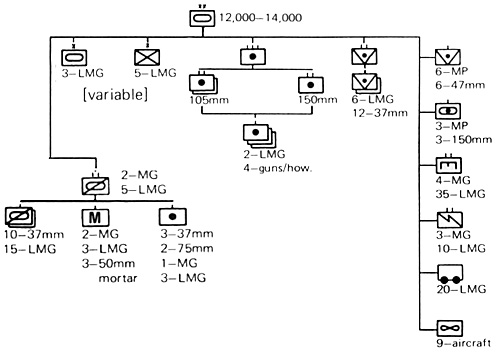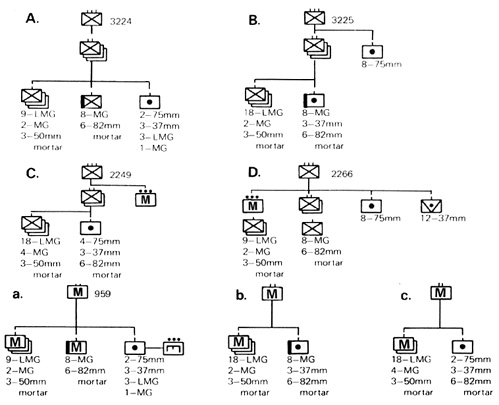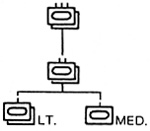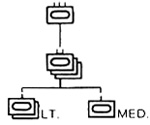Panzer Division
The Panzer Division was the strongest unit in terms of firepower, training, and leadership in the 1940 campaign. The basic outline is shown here, those units which varied in organizational structure from division to division are listed in the charts on these pages.
All divisions comprised a reconnaissance battalion with an authorized strength of fifty-six armoured cars. A squadron of nine reconnaissance aircraft was supposed to be included with the division, but operations showed this to be confusing and the air reconnaissance for the panzer divisions was left to the Luftwaffe. The tank regiments and infantry regiments were grouped under brigades for administrative purposes; the brigade served no tactical function.
A motorized artillery regiment of three battalions, two of 150mm guns and one of 150mm howitzers, each containing three batteries of 4 guns apiece gave the division much-needed fire power when the tanks ran up against superior armoured vehicles or fortified positions. An anti-tank battalion of light 37mm PAK guns of two companies [divisions 1, 2, 5, 9, and 10 had three companies] was supposed to protect the infantry and support troops from enemy armour. Sometimes an extra anti-tank battalion would be assigned to the divisions. A self-propelled (SP} company of 47mm PAK anti tank guns and one of heavy 150mm guns were often assigned to each division.
Originally all 10 panzer divisions had anti-aircraft battalions, the 9th having two, all others having one, but these were withdrawn and placed under command of the Flak Korps responsible for protecting the bridges over the Meuse, remaining with the korps for the duration of the campaign.
Engineers, including a bridging unit, were organized in battalions of four companies. A signal battalion was responsible for rapid communications -- one of the secrets of the tremendous success the panzer forces had. Medical, supply, and other support troops made up the remainder of the division, the most notable among these being the tank recovery unit which kept the division close to full potential in spite of many constant mechanical breakdowns.
AFV: 250-370
APC: 421
M/C: 2,000
Vehicles: 1,963
Weapons of the panzer divisions included 250-370 Armoured Fighting Vehicles (AFV): tanks, armoured cars, and HQ armoured command vehicles (tanks with one MG and increased radio equipment). 421 Armoured Porsonnel Carriers (APC) were authorized, as well as 2,000 solo and combination {side-car) motorcycles, and 1,963 trucks, cars, and other vehicles. Besides the 7.92mm MGs, 20mm, 37mm, and 75mm guns mounted on the AFVs, there were up to 80 37mm PAK anti-tank guns, 63 50mm and 82mm mortars, 18 75mm light infantry guns, 24 105mm heavy guns and 12 150mm howitzers, 466 light and heavy machine guns (LMG and MG) and machine pistols (MP) sub machine guns. Weapon strength varied from division to division.

|
Divisions 1, 2, and 10 as shown. Divisions 3, 4, and 5 had one additional light company per battalion. Total of 4 battalions in 2 regiments.
|
Divisions 6, 7, and 8 as shown. Total of 3 battalions in one regiment. Division 9 had one less battalion.
|
 The establishment of a light and medium command would vary greatly. Due to a shortage of
Pz III tanks, Pz II types often supplanted them. Pz I tanks made up the bulk of light companies in many cases, and a Zug (platoon) would be removed from each company of understrength divisions. Establishment total for the ten panzer divisions was 82 light and 35 medium companies in 35 battalions.
The establishment of a light and medium command would vary greatly. Due to a shortage of
Pz III tanks, Pz II types often supplanted them. Pz I tanks made up the bulk of light companies in many cases, and a Zug (platoon) would be removed from each company of understrength divisions. Establishment total for the ten panzer divisions was 82 light and 35 medium companies in 35 battalions.
Rifle Regiment
Organization charts A -- C show the Schutze (literally "Rifle") regiment types used as the infantry component of the Panzer Division These regiments (re-named Panzergrenadier in 1942) either had their infantry companies carried by APCs or unarmoured half-track vehicle Panzer Division 1 had seven of its 15 infantry companies carried in APC, three in motorcycles with side cars, and the remainder in unarmoured half-tracks. There were not enoug APCs or unarmoured half-tracks to transport all of the panzer divisions' infantry, and truck sometimes had to be used instead.
Chart D is the Motorizerd/Infantry Regiment which had all of its troops carried by truck.
Charts a -- c are the Kradschutzen or motorcycle battalions included with 7 of the panzer divisions.
The number and types of weapons in each company is given, along with regiment or batts included light and heavy machine guns (LMG & MG), 50 and 82mm mortars, 75m light infantry guns, and 37mm PAK anti-tank guns.

More 1940
-
1940: Campaign in France
1940: Campaign in France: Military Dictionary
1940: Campaign in France: TO&E: French
1940: Campaign in France: TO&E: British
1940: Campaign in France: TO&E: German
1940: Campaign in France: Tank Illustrations and Specs
1940: Campaign in France: Anti-Tank Gun Comparison
1940: Campaign in France: Order of Battle Numerical Charts
Related
Back to Conflict Number 1 Table of Contents
Back to Conflict List of Issues
Back to MagWeb Master Magazine List
© Copyright 1998 by Dana Lombardy
This article appears in MagWeb (Magazine Web) on the Internet World Wide Web.
Other military history articles and gaming articles are available at http://www.magweb.com

